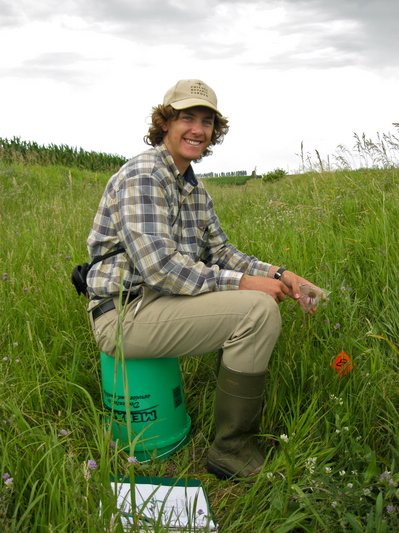|
|
Today was a big day for remnant phenology surveys–possibly our biggest of the season. We made the process more efficient by not recording style persistence on flowers on their 3rd, 6th, 7th, and 8th days of flowering.
But we didn’t stop there. We also collected pollen, painted bracts, and performed the first crosses with the 10 focal plants at Riley. Each focal plant was crossed with its nearest neighbor, its farthest neighbor within the remnant, the earliest flowering plant, and the latest flowering plant. This is to help us understand how compatibility varies across space and flowering time.
In other news, Will and I saw an immature bald eagle amongst the gulls and turkey vultures at the landfill.
Here’s a copy of the poster that I submitted for the poster session at the University of Minnesota. It has some preliminary results as well as a list of future data analysis that I want to complete.
kapsar_UofMPoster.pdf
Lydia mapped many Echinacea plants in two remnants: eelr and alf. Here is a list of distances in meters between all pairs of plants.
distancesForLydia.RData
This version of Lydia’s R script will read her dataset and edit it and then read the distances and merge them to her compatibility dataset.
mergeScriptForLydia.R
Now that the vast majority of Echinacea are finished flowering (except for the populations at Staffanson and one lonely plant at Northwest of Landfill), I’ve started piecing together a master datasheet with the first and last day of flowering for every Echinacea head that I have been studying. Please let me know if you have any comments or recommendations for statistical analysis, possible comparisons to other data sets, or better organizational methods!
phen_mastersheet_2012.csv
phen_mastersheet_2012_metadata.doc
After a good 3 months of sunshine and storms and flower-counting, it’s time to head back to civilization and school. Here are my project status updates and associated files. The doc files (MWang_Dichanthelium.doc and MWang_Compatophen.doc) explain what the associated documents are. Some files (perhaps older versions) can be found on the shared drive.
Dichanthelium:
ProjectStatusMWang_Dichanthelium.doc
MWang_Dichanthelium.doc
Dichanthelium_Protocol_FieldMethods.doc
Dichant_DE_All_2Sep2011.xls
Dichant_ReturnsSummary.xls
Dichant_ReturnsDatasheet.xls
Scanned datasheets that don’t really have much information:
View image
View image
View image
View image
CompatoPhen:
ProjectStatus_MWangCompatophen.doc
MWang_Compatophen.doc
Compatophen_PrelimAnalysis.xls
Compatophen_SamplingCheck.xlsx
I will be continuing work on my projects in the fall.
Here’s the final dataset for my compatibility experiment. The experiment is officially ended today (I collected the last bit of data). The dataset contains GPS data (column name distBetween). I missed one plant while GPS-ing, so I used the hand-measured data (for flag #6 at Nessman’s). I also corrected several errors in the datasheet.
Data for Analysis — cswitzer — 31 July 2011.csv
We spent some time GPS-ing the plants, so we could get the exact distances between them. Here is a csv file with the gps data.
I have been working on analyzing all my data. I looked at plots of each of my individual sties, as well as all the data combined. The data are almost exactly opposite of what I expected.
Here’s the script I’ve been exploring:
callinCompatRScript31july2011.R
Here’s a picture of Josh, Amber Z, and I out in the field (having a lot of fun).

Here is the csv file to use for my compatibility of Echinacea in the remnants.
Preliminary analysis–july 25 2011.csv
Here’s a picture of what we were doing to collect this data!

Here are google doc links to the most up-to-date proposals by Callin, Amber, and Maria
https://docs.google.com/document/d/10Rxr9ucX6qGznUU0Dv1HFfdcgL2WRkXOHZhoJCfYSlA/edit?hl=en_US&pli=1
https://docs.google.com/document/d/1WJw0YH_KUgAH-gJFxL2lQQOA0ofHuRT-pXlIEASULdc/edit?authkey=CPOpx2E&hl=en_US
Here is a csv file of my compiled compatibility, distance, and phenology of my crosses ready to be put into R.
ian.stat.results.2010.csv
Ian wants to quantify the overlap of flowering time between all pairs of plants in his experiment. This following R script reads his file with the flowering schedule of all 31 plants in his experiment and writes a file called ianPhenPairs.csv that has the flowering schedule of every possible pair combination (one per line). Note that there is a separate record for each plant as a sire and dam.
# script ian.phenology.r
pp <- read.csv("https://echinaceaproject.org/wp-content/uploads/ian.phenology.final.csv")
str(pp)
p <- merge(pp,pp, by = NULL)
str(p)
31^2 == dim(p)[1]
write.csv(p, “ianPhenPairs.csv”, row.names = FALSE)
|
|


